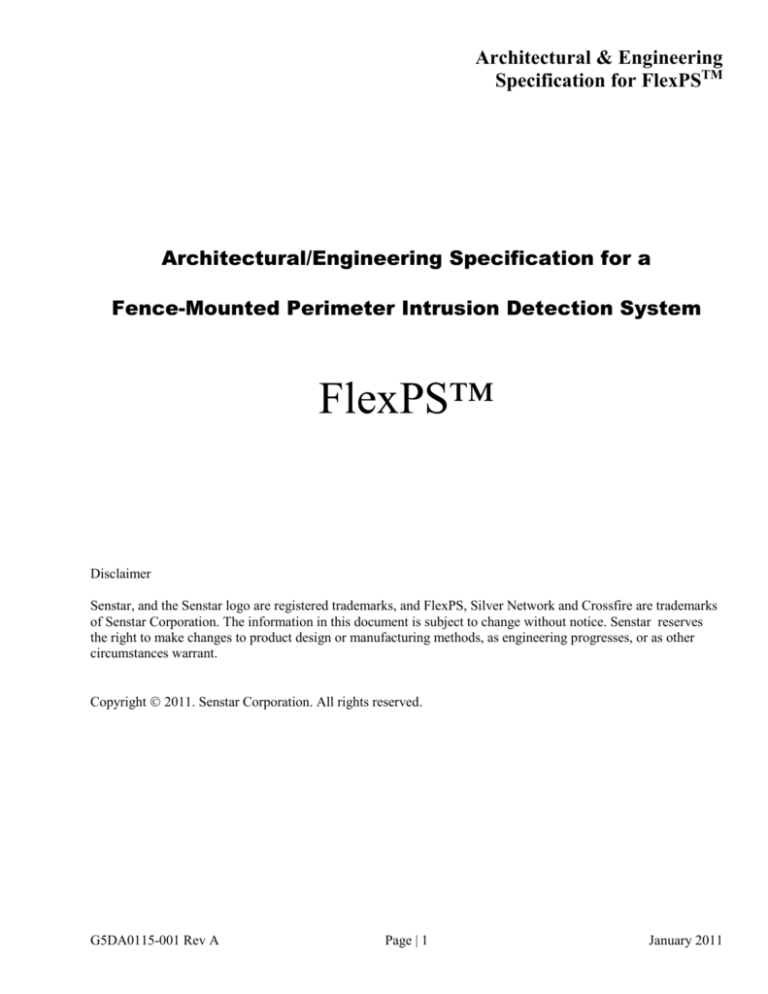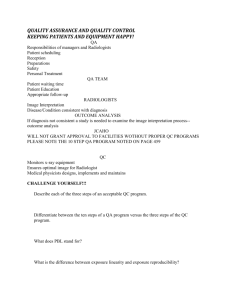
Architectural & Engineering
Specification for FlexPSTM
Architectural/Engineering Specification for a
Fence-Mounted Perimeter Intrusion Detection System
FlexPS™
Disclaimer
Senstar, and the Senstar logo are registered trademarks, and FlexPS, Silver Network and Crossfire are trademarks
of Senstar Corporation. The information in this document is subject to change without notice. Senstar reserves
the right to make changes to product design or manufacturing methods, as engineering progresses, or as other
circumstances warrant.
Copyright 2011. Senstar Corporation. All rights reserved.
G5DA0115-001 Rev A
Page | 1
January 2011
Architectural & Engineering
Specification for FlexPSTM
G5DA0115-001 Rev A
Page | 2
January 2011
Architectural & Engineering
Specification for FlexPSTM
Part 1
General - Fence Mounted Perimeter Intrusion Detection System ............................................... 4
1.1
System Summary .......................................................................................................................... 4
1.2
Submittals ..................................................................................................................................... 4
1.3
Spares ........................................................................................................................................... 4
1.4
Product Support ............................................................................................................................ 4
Part 2
Products - Fence Mounted Perimeter Intrusion Detection System.............................................. 4
2.1
Fence Mounted Perimeter Intrusion Detection System ............................................................... 4
2.2
Manufacturers .............................................................................................................................. 4
2.3
Regulatory Requirements ............................................................................................................. 5
2.4
System Manufacturing Quality Requirements.............................................................................. 5
2.5
Fence Mounted PIDS with Standalone Processors ....................................................................... 5
2.6
Networking Capabilities ................................................................................................................ 9
Part 3
Execution - Fence Mounted Perimeter Intrusion Detection System .......................................... 10
3.1
Site Assessment .......................................................................................................................... 10
3.2
System Installation ...................................................................................................................... 10
3.3
System Calibration ...................................................................................................................... 10
3.4
Training ....................................................................................................................................... 11
G5DA0115-001 Rev A
Page | 3
January 2011
Architectural & Engineering
Specification for FlexPSTM
PART 1
GENERAL - FENCE MOUNTED PERIMETER INTRUSION DETECTION
SYSTEM
1.1
SYSTEM SUMMARY
A The contractor shall install a fence-mounted electronic perimeter intrusion detector. The
system shall be used to protect the perimeter of the facility from unauthorized intrusions.
The system shall consist of a sensor cable and a microprocessor-based dual zone signal
processor. The system shall detect intruders by processing electrical signals generated by
the minute vibration of the sensor cable caused by intruders cutting, climbing, or lifting
the fence fabric. The system shall be integrated into the facility’s Security Management
System.
1.2
SUBMITTALS
A Contractor submittals to the facility owner (“Owner”) shall include the following as a
minimum:
.1
.2
.3
.4
1.3
site conditions report per article 3.1
configuration and calibration settings for each processor in the system after
installation and calibration are complete per article 3.3
sensitivity plots for each zone in the system per article 3.3
all manufacturer-supplied calibration and operating software for the system
SPARES
A The contractor shall deliver to the Owner spare system components consisting of:
.1
1.4
for each system component a minimum quantity of one or 10% of the number
that comprise the system, whichever is greater
PRODUCT SUPPORT
A The product shall carry a minimum one-year warranty from the date of purchase.
B The supplier shall warrant that the product shall be supported by spare parts and
assemblies for a minimum of 10 years from date of purchase.
PART 2
PRODUCTS - FENCE MOUNTED PERIMETER INTRUSION DETECTION
SYSTEM
2.1
FENCE MOUNTED PERIMETER INTRUSION DETECTION SYSTEM
A The contractor shall supply a fence-mounted Perimeter Intrusion Detection System
(PIDS). The fence-mounted PIDS shall detect intruders attempting to breach the
perimeter fence by cutting, climbing, or lifting the fence fabric.
2.2
MANUFACTURERS
A The FlexPS™ system from Senstar Corporation (www.senstar.com ) meets the
requirements stated herein for a fence-mounted PIDS and shall be the basis of design.
G5DA0115-001 Rev A
Page | 4
January 2011
Architectural & Engineering
Specification for FlexPSTM
2.3
REGULATORY REQUIREMENTS
A The system shall comply with FCC 47 CFR Part 15, Subpart B requirements for Class A
devices.
B The system shall comply with EN 61000-6-4: 2007.
C The system shall comply with EN 50130-4: 1995 + amendments A1:1998 & A2:2003.
D The system shall comply with Industry Canada ICES-003, Issue 4 requirements for Class
A devices.
2.4
SYSTEM MANUFACTURING QUALITY REQUIREMENTS
A The manufacturer’s quality management system shall be certified as conforming to ISO
9001:2008.
B All electronic elements intended for outdoor installation shall be conformal coated and
units shall be tested during manufacture over their entire operational temperature range
on a sample basis.
C All sensor cable furnished shall be tested over its entire length during manufacture and
test results showing the sensitivity over the length of the cable shall be furnished by the
manufacturer.
2.5
FENCE MOUNTED PIDS WITH STANDALONE PROCESSORS
A Detection Capabilities
.1
Sensor Cable
a. The PIDS sensor shall be a continuous cable that is attached to the fence
along the full length to be protected.
.2
Processor
a. The PIDS processor shall have the following detection capabilities:
.1
process the signal from the sensor cable to detect intruders
attempting to breach the perimeter fence by cutting, climbing, or
lifting the fence fabric
.2
provide two separate zones of detection by independently
processing the signal from two sensor cables
.3
each sensor cable forming a zone can be up to 300 m (984 ft.) in
length
.4
use digital signal processing techniques
.5
provide separate calibration settings for each zone
.6
be capable of being calibrated to function on different types of
metal fencing including but not limited to chain-link, expanded
mesh, and welded mesh. The calibration capabilities shall
include setting the lower and upper frequency limits that the
processor responds to in increments of 100 Hertz in order to
optimize the processing to the specific characteristics of the
fence
G5DA0115-001 Rev A
Page | 5
January 2011
Architectural & Engineering
Specification for FlexPSTM
.7
.3
utilize adaptive algorithms in the detection process to optimally
discriminate between actual intrusions and environmental
activity
.8
utilize the sensor input from both zones in the detection process
to optimally discriminate between actual intrusions and nuisance
alarms caused by environmental effects such as high winds that
affect both zones (this processing technique is known as
common mode rejection)
System Detection Performance
a. The probability of detection (Pd) of an intruder cutting the fence, lifting
the fence fabric, or climbing unaided over the fence shall be 95% with a
95% confidence factor, when the system is installed according to the
manufacturer’s directions.
B False Alarm Rate
.1
The maximum rate for alarms generated by internal electronic processes of the
processors (cables excluded) shall be less than one per zone per year, averaged
over the total number of zones in the system.
C Nuisance (Environmental) Alarms
.1
.2
The system shall not suffer nuisance alarms from any of the following sources:
b. ambient temperature changes
c. motion of nearby objects or vegetation that are not striking the fence
d. motion of surface or ground water
e. sunrise/sunset
f. seismic vibration caused by nearby vehicular or rail traffic
g. acoustic or magnetic effects
h. snow
i. fog
The system shall utilize adaptive processing and ambient compensation to
minimize the probability of nuisance alarms from the following sources:
a. wind
b. rain and hail
c. sandstorms
D Fence Compatibility
.1
E
The system shall provide the specified detection performance when installed on
different types of metal fencing including but not limited to chain-link, expanded
mesh, and welded mesh. It shall be possible to use multiple passes of sensor
cable to obtain the specified detection performance for fences of any height. The
manufacturer shall provide guidelines regarding the height of fence that can be
protected with one, two, and multiple passes of sensor cable.
Protection of Gates
.1
G5DA0115-001 Rev A
The system shall be capable of monitoring or bypassing swinging and sliding
gates by using a Gate Bypass Module. The system shall be capable of placing
Page | 6
January 2011
Architectural & Engineering
Specification for FlexPSTM
monitored gates in access mode (no alarm when the gate is used), or secure mode
within a secure zone, by either local or remote command.
F
Armored Sensor Cable
.1
The sensor cable shall be available encased in an armor jacket, for use in areas
that have a high potential of physical damage to the cable.
G Standalone Processor Alarm Outputs
.1
The sensor processor shall have a minimum of four Form C relay outputs to
indicate alarm conditions. Each relay shall be rated for up to at least 0.5A at 30V.
For each relay it shall be possible to assign one or more conditions from the
following list under which the relay will activate:
a. side A sensor alarm
b. side B sensor alarm
c. side A supervision alarm
d. side B supervision alarm
e. enclosure tamper
f. input power fail
g. battery fail
h. internal hardware fault
i. fail safe (assert on total loss of power)
H Processor Self-Test Inputs
.1
I
Processor Audio Output
.1
J
The processor shall provide two dry contact inputs that, when the processor is
used in a standalone mode (no network), function as inputs that command a selftest cycle to be performed. Self-test shall consist of internal circuitry tests, testing
cable continuity and termination, and testing of detection processing.
The processor shall provide a high-impedance analog audio output that is an
audio representation of the signal generated by the sensor cable. The audio output
shall be selectable between sensor cable A, sensor cable B, sensor cables A and
B, and inactive.
Tamper Detection
.1
The processor shall detect and indicate tampering conditions including opening
the processor cover and cutting or short-circuiting the sensor cable.
K Processor Calibration Port
.1
L
For calibration purposes the processor shall provide a standard USB connector
for attachment of a Windows PC.
Environmental Operating Range
.1
G5DA0115-001 Rev A
The system shall operate within specifications under the following environmental
conditions:
a. temperatures between -40 C (-40 F) and 70 C (158 F)
b. relative humidity between 0 and 95%, non-condensing
Page | 7
January 2011
Architectural & Engineering
Specification for FlexPSTM
M The processor shall be housed in a painted aluminum enclosure meeting the
requirements of NEMA 4X and IP 66.
N Standalone Processor Input Power
.1
The processor when used in a standalone mode (no network) shall accept DC
power ranging from 12 to 48V and require less than 0.5 watt.
O Processor Internal Battery Backup
.1
P
There shall be an option for the processor to have an internal backup battery.
When fully charged the internal backup battery shall be capable of powering the
FlexPS processor for a minimum of 12 hours. The processor shall include a
battery charging circuit to charge the internal backup battery.
Processor Reliability and Maintainability
.1
The processor shall have a predicted mean time between failures (MTBF) of
greater than 100,000 hours when calculated per Telcordia Reliability Prediction
Procedure, Parts Count Method, at 70°C. The processor shall have a mean time to
replace (MTTR) of less than 10 minutes.
Q Lightning Protection
.1
The processor shall provide both transorb and gas discharge devices on all inputs
and outputs including power.
R Ease of Installation
.1
S
Processor Locking
.1
T
The system shall be simple to install and shall have the following characteristics
as a minimum:
a. the sensor cable must be capable of being attached directly to the fence
without needing to be put in a conduit
b. the sensor cable must be capable of being attached to the fence with
standard UV-resistant cable ties
c. it shall be possible to mount the processor directly on a fence post that
forms part of the fence to be protected
d. it shall be possible to connect the sensor cable directly to the processor
without the need for any intermediary cable
e. all electrical connections to the processor, including the sensor cables,
shall be made with screw-terminals on removable connectors
f. cable ingress/egress shall be accommodated by cable glands that require
no additional sealing compounds to provide an environmental seal
g. configuration and calibration shall be accomplished via a Windowsbased software tool with an intuitive graphical user interface
h. it shall be possible to store processor configuration and calibration
settings to a computer file for record keeping and to use the stored file to
configure other processors and/or a replacement processor
The system manufacturer shall provide an optional kit that allows the processor
cover to be locked with a padlock.
Backwards Compatibility
G5DA0115-001 Rev A
Page | 8
January 2011
Architectural & Engineering
Specification for FlexPSTM
.1
2.6
The system manufacturer shall provide optional retrofit kits to allow the
processor to be installed in Senstar Intelli-FLEX™ enclosures and Senstar
(MSi/PPI) FPS-2 and FPS-5 enclosures. The processor shall be compatible with
the sensor cables used by these systems.
NETWORKING CAPABILITIES
A When a network-capable system is required the requirements of this section shall apply.
.1
System with Network Capability
a. The processors shall be capable of communicating alarm, status, and
configuration information to and from a central location over an
integrated sensor network.
B Physical Media Options
.1
The processors shall provide the following physical media options for the sensor
network:
a. EIA-422 capable of point-to-point runs of up to 1.2 km (4,000 ft.)
b. multi-mode fiber optic capable of point-to-point runs of up to 2.2 km
(7,200 ft.)
c. single-mode fiber optic capable of point-to-point runs of up to 10 km
(32,000 ft.)
C Redundant Network Communications
.1
The sensor network shall be capable of being connected in a loop configuration
and of being polled from both ends of the loop to provide redundant
communications paths to each processor.
D Network Management
.1
E
Network-Based Global Sensor Processing
.1
F
The system shall include network management software to manage the
communications over the sensor network. The network management software
shall be capable of running on a standard Windows PC.
The system’s network management software shall include a global sensor
processing capability such that activity on multiple zones of the system is
evaluated in making alarm decisions.
Network Management Software Interfaces
.1
G5DA0115-001 Rev A
The system’s network management software shall provide the following
interfaces:
a. a TCP/IP-based interface for communicating alarm, status, and
configuration data to and from security management systems. The
system supplier shall furnish complete documentation of this interface to
facilitate integration with security management systems.
b. a TCP/IP-based interface to be used by the system’s PC-based software
calibration and configuration tool to allow calibration and configuration
of all processor settings to be done from a central location once the
device address is set on the processor
Page | 9
January 2011
Architectural & Engineering
Specification for FlexPSTM
G Network Manager Tools
.1
The system’s network management software shall provide the following tools to
facilitate system commissioning and trouble-shooting:
a. system status tool that provides a visual display of the status of all
processors in the system
b. system event log tool that provides a searchable log of system events
c. system plot tool that can store and recall the instantaneous response data
for all networked sensors and display a plot of the instantaneous response
from a minimum of 8 sensor zones simultaneously
H Networked Processor Dry Contact Inputs
.1
I
Networked Processor Relay Outputs
.1
J
In networked mode the processor dry contact inputs shall function as generalpurpose supervised inputs and the state of the dry contact inputs shall be
communicated over the network.
In networked mode the processor relay outputs shall function as general-purpose
outputs and the state of the relay outputs shall be controlled via the network.
Networked Processor Self-Test
.1
In networked mode it shall be possible to initiate a self-test over the network.
K Networked Processor Input Power
.1
L
The processor when used in networked mode (with network card installed) shall
accept DC power ranging from 12 to 48V and require less than 1.0 watt.
Network Backwards Compatibility
.2
The system processors shall be capable of interfacing to Senstar Crossfire and
CEnDe networks and provide the full range of communications capabilities as
provided by those networks.
PART 3
EXECUTION - FENCE MOUNTED PERIMETER INTRUSION DETECTION
SYSTEM
3.1
SITE ASSESSMENT
A Before installation begins, the installation contractor shall provide a report to the Owner
documenting any site conditions that may prevent the system from operating
satisfactorily. Examples of such conditions include excessively loose fence fabric and
objects such as signs and tree branches hitting the fence.
3.2
SYSTEM INSTALLATION
A The system shall be installed in accordance with the manufacturer’s recommended
procedures as defined in the manufacturer’s Product Guide for the system.
3.3
SYSTEM CALIBRATION
A The installation contractor shall calibrate the system in accordance with the
manufacturer’s recommended procedures as defined in the manufacturer’s Product
G5DA0115-001 Rev A
Page | 10
January 2011
Architectural & Engineering
Specification for FlexPSTM
Guide. The installation contractor shall submit to the Owner the calibration and
configuration settings for each processor in the system. The installation contractor shall
submit to the Owner a response plot for each zone in the system.
3.4
TRAINING
A The installation contractor shall train the Owner’s maintenance personnel in the
calibration and system maintenance procedures as given in the manufacturer’s Product
Guide.
G5DA0115-001 Rev A
Page | 11
January 2011







